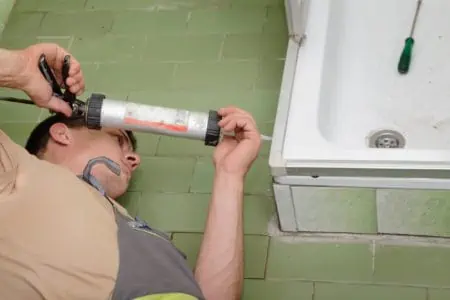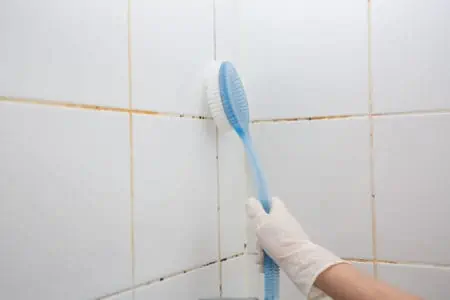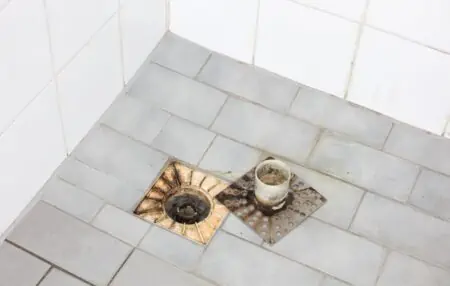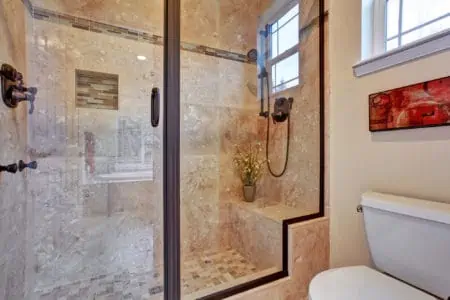Fiberglass showers are much better at resisting mold and other harmful bacteria than a porcelain bathtub or toilet. But that doesn’t mean they don’t get dirty. Cleaning a fiberglass shower with the wrong cleaning agent risks damaging the surface of the shower.
We rundown the top detergents to clean a fiberglass shower, ensuring you get the best results without damaging the shower’s surface.
Key Takeaways
- Use dish soap for removing soap scum and dirt, but not for hard water stains and mineral deposits.
- Combine baking soda and vinegar to lift stubborn stains like mineral deposits and rust around the drain hole.
- Use vinegar for cleaning soap scum, mildew, and deodorizing the fiberglass shower without damaging the surface.
- Try commercial cleaners like CLR, Bar Keepers Friend, or Magic Eraser for hard water stains, rust, and mineral deposits, but always follow the manufacturer’s instructions.
How To Clean a Fiberglass Shower
With so many cleaning products on the market designed to clean your fiberglass shower, you might be surprised to learn that some of the most effective solutions sit in your cupboard already.
Let’s take a look at the best methods.
Dish Soap
If you are cleaning soap scum and dirt from the shower tray, dish soap is a perfect choice. You will need:
- A nylon scrubber.
- A quarter of a cup of dish soap.
- A spray bottle.
- Warm water.
Add the dish soap to the spray bottle and fill it to the top with warm water. Spray the entire surface of the shower stall from top to bottom and leave the dish soap to soak in for a few minutes.
Grab the nylon scrubber and gently wipe over all the surfaces, ensuring that the soap scum is removed. Rinse with warm water and repeat for the best results.
Baking Soda and Vinegar
Baking soda is a superstar of the cleaning world, but when you combine it with vinegar, it is out of this world. Once you mix it into a solution and apply it over the toughest stains, it gets straight to work.
You will need:
- 2 cups of baking soda.
- 2 cups of vinegar.
- A nylon scrubber.
- A spray bottle.
To make up the solution, fill the spray bottle with vinegar. Sprinkle the baking soda on the stubborn stains, and then apply the vinegar on each spot.
Let the paste sit for 15 minutes as it fizzes and gets to work. When the time elapses, attack the stain with the nylon scrubber until it disappears. Rinse down with warm water and repeat if the stain is still evident.
Vinegar
Vinegar isn’t just for pickling. It is one of the great underused home remedies for cleaning bathroom fixtures. It attacks stains and deodorizes at the same time. If you have soap scum or mildew, vinegar is effective without damaging the surface of the fiberglass shower.
Here’s what you need:
- 1 cup of white vinegar.
- A spray bottle.
- 1 cup of warm water.
- 5 drops of essential oils.
- A nylon scrubber.
Mix all the ingredients in the spray bottle and apply liberally to the entire surface of the shower. Wait 5 minutes while the solution does its job, and then scrub from top to bottom using the nylon scrubber.
Rinse the enclosure down with warm water, and then repeat the process if you need to.
Commercial Cleaner
Commercial cleaners usually come in the form of liquid rust and mineral removers known as CLR. This product is awesome for shifting hard water stains caused by excess mineral build-up, which is common in areas with hard water.
The drain and shower tray are particularly susceptible to rust stains and hard water stains. Always follow the maker’s instructions and double-check if it is suitable for your shower enclosure.
You will need:
- 1 Spray bottle.
- A bottle of commercial cleaner.
- A nylon scrubber.
- Dish soap.
- Warm water.
Fill the spray bottle with a capful of the commercial cleaner and the warm water, and spray liberally over the surfaces where the staining is most prevalent. Leave it to settle for 30 minutes, and then wash away using warm water.
If the stain resists, use the nylon scrubber and dish soap to attack the area. Rinse it off and repeat the process all over again.
Bar Keepers Friend
Bar Keepers Friend is another commercial cleaner that works on multiple household surfaces. It cleans sinks, toilets and bathtubs, as well as shower stalls. It even cleans your oven!
It is excellent for cleaning fiberglass shower enclosures without leaving any damage and works on most marks, including mold and mineral deposits.
You will need:
- Gloves.
- Bar Keepers Friend spray cleanser.
- A nylon scouring pad.
- Warm water.
Wet all the surfaces of the shower, including the panels and doors. Spray the Bar Keepers Friend in the stall and allow it to sit for a few minutes. Put on the gloves, scrub the entire shower cubicle, and then rinse the walls, doors and shower stall with warm water.
Allow the shower to dry, and if necessary, repeat the process.
Magic Eraser
Magic Eraser is a melamine foam that removes stains by acting as a mild abrasive. It is perfect for cleaning marks on fiberglass showers because it causes them no harm.
You will need:
- Gloves.
- Magic Eraser.
- Warm water.
First, wet down the sides of the shower, including the stall. Second, scrub away the stains with the Magic Eraser, taking care that you don’t apply too much pressure. They should come away without too much of a fight.
Give the shower a rinse a couple of times to wash away any bits of eraser and to keep the shower damp. Keep doing this until the shower is clean.
Borax
If you’ve tried baking soda, and the stains are still not shifting, reach for the Borax to get the job done. Borax is similar to baking soda, except you wouldn’t want to cook with this stuff.
It removes almost every type of staining, including hard water rings. Here’s what you need:
- 2 cups of Borax.
- Scrub brush or toothbrush.
- 2 cups of white vinegar.
- A spray bottle.
Fill the spray bottle with white vinegar and cover the stains with a coating of Borax. Spray the vinegar over the Borax and wait 15 minutes while the chemical reaction takes place.
Use the scrubbing brush or old toothbrush to grind the paste into the stain, then rinse with water. If you need to repeat the procedure, do it as many times as you like until you are satisfied that the marks are gone.
Bleach
Bleach is a pretty harsh chemical cleaner and needs to be used safely with gloves. It is excellent for cleaning mold, mildew and soap scum but not so great for hard mineral deposits.
Here’s what you need:
- 1 tsp of bleach.
- 1 spray bottle.
- 2 cups of warm water.
- A nylon scrubber.
Put on the gloves and pour the bleach and water into the spray bottle. Now coat all the surfaces in your shower with the solution. Allow 10 minutes while the bleach does its thing, and then attack the mold and mildew with the scrubber. When you are satisfied you have cleaned it away, rinse the shower down with warm water.
If some mildew or mold remains, repeat the process until it’s all gone.
Lemon Juice
Lemon juice contains a mild acid that’s perfect for washing down the surfaces of your shower stall to remove surface grime and soap scum.
Here’s what you need:
- 1 cup of lemon juice.
- 1 cup of water.
- 1 spray bottle.
- A nylon scrubber.
Pour the water and lemon juice into the spray bottle and apply liberally to the surface of your shower, paying particular attention to the areas with the most grime and soap scum. Leave it to work for 5 minutes.
Then, scrub for all you are worth using the nylon scrubber. When you are satisfied, rinse the solution away using warm water.
Floor Wax
Apply the wax to your shower’s walls, especially when you see the surfaces start to dull. Prevention could be better than the cure here.
Avoid putting wax on the shower floor because this could make the surfaces very slippery unless you have a non-slip floor mat.
Here’s what you need:
- Liquid floor wax.
- Microfiber cloth.
- Paper towels.
- Gloves.
Check the manufacturer’s instructions before you get to work. Add a bit of wax on a paper towel and apply it to the shower walls. Allow the wax to dry, and then wipe it away with the microfiber cloth, buffing it to a high shine.
The wax should last a while, leaving your surfaces gleaming and repelling water with ease.
Fiberglass Shower Cleaning Tips
What are the tips and tricks to help clean your shower enclosure and keep it sparkling fresh? Here are some tips.
Identify the Material Surface
Knowing what surface you are dealing with will help you select the correct cleaning products. Fiberglass and plastic are better when you use dissolving solutions that don’t require harsh scrubbing, which could scratch the surface of your shower.
Wet the Shower
Wetting the shower allows the cleaning solution to apply evenly, coat the surface, and dissolve the staining. It also helps your shower breathe, which reduces instances of mold and mildew.
Squeegee Dry
When you have finished cleaning the shower, getting all the moisture off the surface is crucial if you want to get a streak-free finish. A squeegee is the perfect tool, as it gets close to the surface and removes more water than a cloth.
Baking Soda and a Sandwich Bag
Drop some baking soda in a sandwich bag and pull it over the showerhead to eat away at the scum. Use a rubber band and wrap it around the head or the shower.
Leave it overnight as the baking soda dissolves the grime. The following day, remove the bag and rinse away the baking soda.
Don’t Use Abrasive Pads
Abrasive scourers like dish scourers and wire wool pads are bad for your fiberglass shower. They scratch the surfaces, creating a dull finish. It may clean away the grime, but it will leave your shower looking less than appealing.
Can You Use a Magic Eraser on a Fiberglass Shower?
A Magic Eraser is an excellent product to use on a fiberglass shower, as long as you don’t press down too hard on the surface. Some people recommend that you use an oven cleaner in conjunction with the Magic Eraser.
Leave it on the shower for 10 minutes, and then rinse it away, and you should have a gleaming surface.






